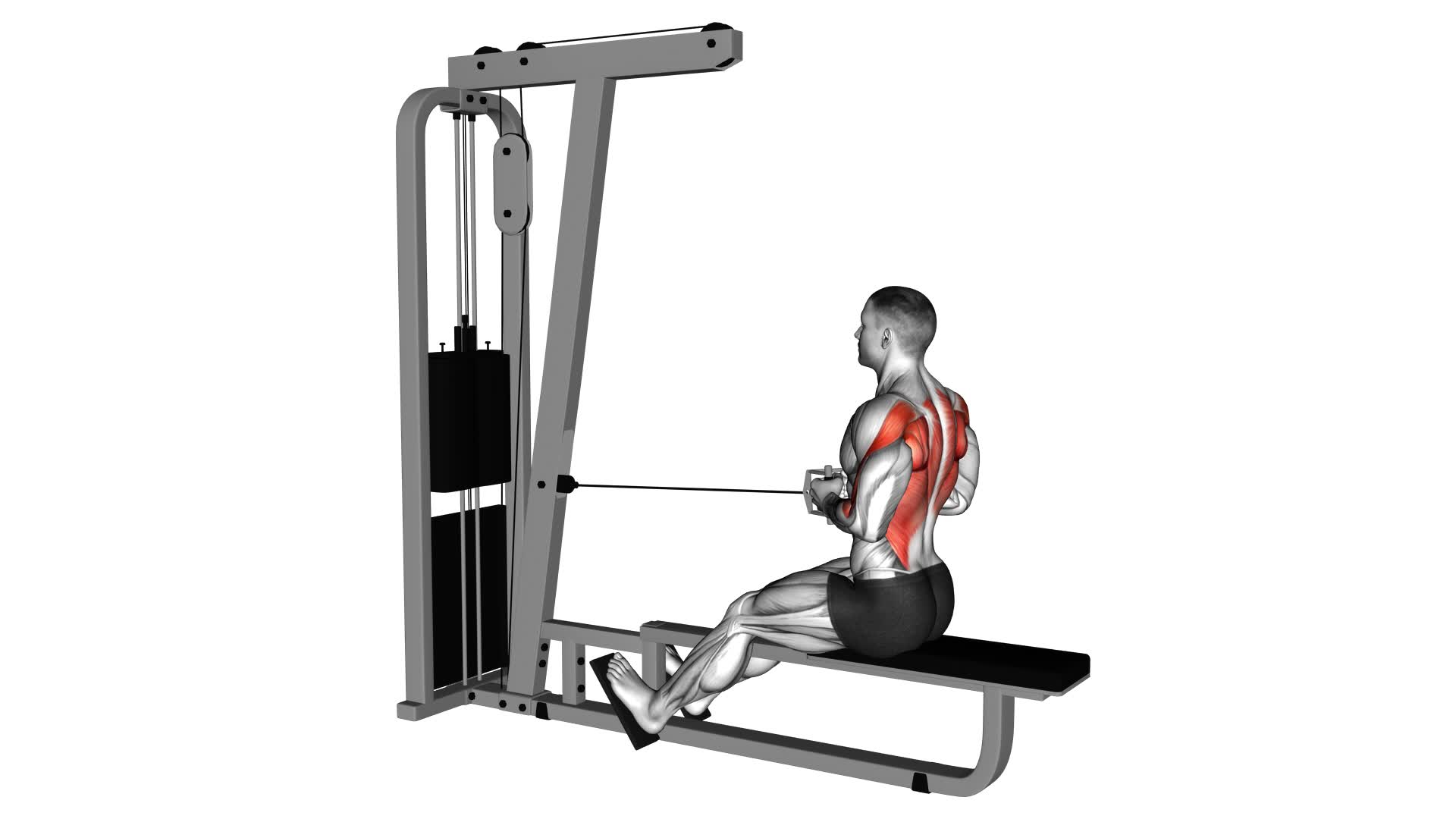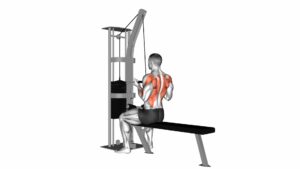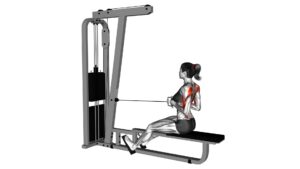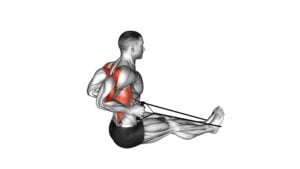Cable Straight Back Seated Row – Video Exercise Guide & Tips

Looking to strengthen your back muscles? Check out this video exercise guide and tips for the cable straight back seated row.
Watch This Exercise Video
You'll learn the benefits, equipment setup, proper form, variations, and common mistakes to avoid.
Maximize your workout with these expert tips and get the most out of your cable straight back seated row routine.
Let's get started and achieve those strong and toned back muscles!
Key Takeaways
- Engages back muscles and improves overall strength and posture
- Targets specific muscles including latissimus dorsi, rhomboids, and trapezius
- Increases back strength, leading to improved stability and reduced risk of back pain
- Engages multiple muscle groups including biceps, forearms, and shoulders
Benefits of Cable Straight Back Seated Row
Experience the numerous benefits of the Cable Straight Back Seated Row by engaging your back muscles and improving overall strength and posture. This exercise specifically targets the muscles in your back, including the latissimus dorsi, rhomboids, and trapezius. By performing the Cable Straight Back Seated Row with proper form and technique, you can reap a multitude of benefits.
One key benefit of this exercise is increased back strength. As you pull the cable towards your body, your back muscles are activated and strengthened. This can lead to improved posture and stability in your daily activities, as well as reducing the risk of back pain and injury.
Another advantage of the Cable Straight Back Seated Row is its ability to target multiple muscle groups simultaneously. In addition to the back muscles, this exercise also engages the biceps, forearms, and shoulders. This compound movement helps to build overall upper body strength and muscle definition.
Furthermore, the Cable Straight Back Seated Row can be easily modified to suit your fitness level and goals. By adjusting the weight and resistance, you can challenge yourself and continually progress in your strength training journey.
Equipment and Setup for Cable Straight Back Seated Row
To properly set up for the cable straight back seated row, ensure the cable height is adjusted to chest level, allowing for a full range of motion.
Position yourself on the seat with your feet firmly planted on the ground and your knees slightly bent.
Experiment with different grip variations, such as overhand or underhand, to target different muscles in your back.
Proper Cable Height
Adjust the cable height for the seated row exercise by using the appropriate equipment and setup. To ensure proper cable attachment, make sure the cable is securely attached to the machine. This will prevent any accidents or injuries during your workout.
As for the recommended weight for beginners, start with a weight that challenges you but allows you to maintain proper form. It's important to find the right balance between weight and technique to avoid strain or injury. Gradually increase the weight as you become more comfortable and confident with the exercise.
Remember to consult with a fitness professional or trainer if you're unsure about the appropriate weight for your fitness level.
Correct Seat Position
To ensure proper equipment and setup for the Cable Straight Back Seated Row, position yourself on the seat with your feet firmly planted on the floor. Correct seat posture is crucial for maximizing the effectiveness of this exercise. Sit upright with your back straight and shoulders relaxed. Avoid hunching or slouching, as this can lead to poor form and potential injury.
The importance of seat adjustment can't be overstated. Make sure the seat height is appropriate, allowing your arms to fully extend when gripping the handles. Additionally, ensure that the seat is positioned at a distance that allows for a full range of motion without any restrictions.
Taking the time to properly adjust your seat will help maintain proper form and target the intended muscles effectively.
Necessary Grip Variations
Choose the appropriate grip variation for the Cable Straight Back Seated Row to target specific muscles and optimize your workout. There are different grip techniques you can use to vary the intensity and target different muscle groups. To focus on your back muscles, use an overhand grip with your palms facing down. This grip also helps with grip strength training.
If you want to target your biceps more, try an underhand grip with your palms facing up. This grip variation also engages your forearms. Experiment with different grips to find the one that works best for you.
Now that you know the necessary grip variations, let's move on to discussing the proper form and technique for the cable straight back seated row.
Proper Form and Technique for Cable Straight Back Seated Row
To perform the cable straight back seated row with proper form and technique, it's crucial to maintain correct back positioning and avoid rounding your shoulders.
Keep your back straight and engage your core muscles to support your spine throughout the exercise.
Correct Back Positioning
When performing the Cable Straight Back Seated Row exercise, ensure that you maintain proper back positioning throughout the movement to maximize effectiveness and prevent injury. Here are some key tips to help you achieve correct back posture and muscle activation:
- Sit up tall with your shoulders back and down.
- Keep your chest lifted and avoid rounding your upper back.
- Engage your core muscles to support your spine.
- Avoid arching your lower back or leaning too far forward.
- Maintain a neutral spine position throughout the exercise.
Avoid Round Shoulders
To avoid round shoulders during the Cable Straight Back Seated Row exercise, focus on maintaining proper form and technique. This won't only improve your posture but also strengthen your upper back.
Start by sitting with your back straight and shoulders relaxed. Keep your chest lifted and your core engaged throughout the exercise.
As you pull the cable towards your body, squeeze your shoulder blades together and make sure to keep your shoulders down and back, avoiding any rounding or hunching. This will help activate the muscles in your upper back and prevent excessive strain on your shoulders.
Remember to breathe steadily and maintain control over the movement.
Variations and Progressions of Cable Straight Back Seated Row
For a more challenging workout, you can progress the cable straight back seated row exercise by adding additional weight. This will help you build strength and continue making progress in your training. Here are some variations and progressions you can try:
- Different cable row variations: Instead of using a straight bar, you can use different attachments such as a V-bar or a rope handle. This will target your muscles in slightly different ways and add variety to your workouts.
- Increase the weight: Gradually increase the amount of weight you're lifting to continue challenging your muscles. This will help you build strength and increase the intensity of your workout.
- Decrease rest time: Instead of resting for a long period between sets, try reducing the rest time. This will increase the intensity of your workout and help improve your muscular endurance.
- Perform more repetitions: Increase the number of repetitions you perform for each set. This will help you build muscular endurance and improve your overall strength.
- Superset with other exercises: Combine the cable straight back seated row with other exercises to create a superset. This will challenge your muscles in different ways and help you maximize your workout.
By incorporating these variations and progressions into your cable straight back seated row exercise, you can continue to challenge your muscles and make progress in your strength training journey.
Now, let's move on to the next section and discuss common mistakes to avoid during the cable straight back seated row.
Common Mistakes to Avoid During Cable Straight Back Seated Row
To avoid common mistakes, make sure you maintain proper form while performing the cable straight back seated row exercise. Proper form is crucial for maximizing the effectiveness of the exercise and preventing injuries.
One common mistake is using too much weight. It's important to start with a weight that allows you to perform the exercise with proper form and gradually increase the weight as you get stronger.
Another common mistake is rounding your back during the movement. This not only reduces the effectiveness of the exercise but also puts unnecessary strain on your spine. Instead, focus on keeping your back straight and your shoulders pulled back throughout the entire movement.
Additionally, avoid using momentum to complete the exercise. Using momentum takes away from the targeted muscles and increases the risk of injury. Instead, engage your muscles and perform the movement in a slow and controlled manner.
Finally, make sure to fully extend your arms and squeeze your shoulder blades together at the end of each repetition. This will help to fully engage your back muscles and ensure you're getting the most out of the exercise.
Tips for Maximizing Your Cable Straight Back Seated Row Workout
Maximize your cable straight back seated row workout by focusing on proper form and engaging your muscles throughout the movement. This exercise is an excellent way to target your upper back muscles and improve back strength. To make the most out of your workout, consider these tips:
- Maintain a straight back: Keep your spine neutral and avoid hunching forward or arching your back. This position helps target the intended muscles and reduces the risk of injury.
- Squeeze your shoulder blades: As you pull the cable towards your body, focus on squeezing your shoulder blades together. This contraction engages your upper back muscles and enhances the effectiveness of the exercise.
- Control the movement: Avoid using momentum to complete the row. Instead, concentrate on a slow and controlled motion, emphasizing the contraction of your back muscles throughout the entire range of motion.
- Adjust the cable height: Experiment with different cable heights to target specific areas of your upper back. Lower cable positions emphasize the lower portion of your back, while higher positions target the upper region.
- Vary your grip: Switch between an overhand and underhand grip to engage different muscles in your back. This variation helps prevent muscle imbalances and adds variety to your workout routine.
Frequently Asked Questions
How Many Sets and Reps Should I Do for the Cable Straight Back Seated Row?
For the cable straight back seated row, the optimal number of sets and reps depends on your fitness level and goals. A good starting point is 3 sets of 10-12 reps. Choose a weight that challenges you but allows you to maintain proper form.
To increase intensity, you can add resistance bands or increase the weight. Variations include using different grips or performing the exercise standing up.
Always consult with a fitness professional for personalized advice.
Can I Use Dumbbells Instead of a Cable Machine for This Exercise?
Yes, you can use dumbbells instead of a cable machine for the seated row exercise. However, it's important to note that using a cable machine offers unique benefits.
The cable machine provides constant tension throughout the movement, targeting your back muscles more effectively. Additionally, it allows for a wider range of motion and the ability to adjust the resistance easily.
Nonetheless, if you don't have access to a cable machine, dumbbells can still be a good alternative for working your back muscles.
Is the Cable Straight Back Seated Row Suitable for Beginners?
For beginners, the cable straight back seated row is a suitable exercise to build back strength. However, if you're looking for alternative exercises, dumbbell rows or resistance band rows can be effective options.
When performing the cable straight back seated row, it's important to avoid common mistakes such as rounding your back or using too much weight. By focusing on proper form and starting with lighter weights, you can ensure a safe and effective workout.
Can I Incorporate This Exercise Into a Full-Body Workout Routine?
Yes, you can definitely incorporate the cable straight back seated row into a full-body workout routine. This exercise targets multiple muscle groups, including your back, shoulders, and arms.
By incorporating other cable exercises, you can further engage your muscles and increase the intensity of your workout.
Full-body workouts are beneficial because they allow you to work all major muscle groups in one session, saving you time and maximizing your results.
How Does the Cable Straight Back Seated Row Target Different Muscles Compared to Other Rowing Exercises?
The cable straight back seated row is a great exercise for targeting different muscles compared to other rowing exercises. It specifically targets your back muscles, including the latissimus dorsi and rhomboids, as well as your biceps. By using the cable machine, you have the added benefit of constant tension throughout the movement, which helps to increase muscle activation and strength.
This exercise also offers variations, such as using different grip attachments or adjusting the seat height, to further challenge your muscles and keep your workouts interesting.
Conclusion
In conclusion, the cable straight back seated row is a highly effective exercise for strengthening the back muscles. By using proper form and technique, you can maximize the benefits of this exercise. Remember to avoid common mistakes and incorporate variations to continuously challenge your muscles.
With the right equipment and setup, you can easily incorporate the cable straight back seated row into your workout routine for improved back strength and posture.

Author
Years ago, the spark of my life’s passion ignited in my mind the moment I stepped into the local gym for the first time. The inaugural bead of perspiration, the initial endeavor, the very first surge of endorphins, and a sense of pride that washed over me post-workout marked the beginning of my deep-seated interest in strength sports, fitness, and sports nutrition. This very curiosity blossomed rapidly into a profound fascination, propelling me to earn a Master’s degree in Physical Education from the Academy of Physical Education in Krakow, followed by a Sports Manager diploma from the Jagiellonian University. My journey of growth led me to gain more specialized qualifications, such as being a certified personal trainer with a focus on sports dietetics, a lifeguard, and an instructor for wellness and corrective gymnastics. Theoretical knowledge paired seamlessly with practical experience, reinforcing my belief that the transformation of individuals under my guidance was also a reflection of my personal growth. This belief holds true even today. Each day, I strive to push the boundaries and explore new realms. These realms gently elevate me to greater heights. The unique combination of passion for my field and the continuous quest for growth fuels my drive to break new ground.







